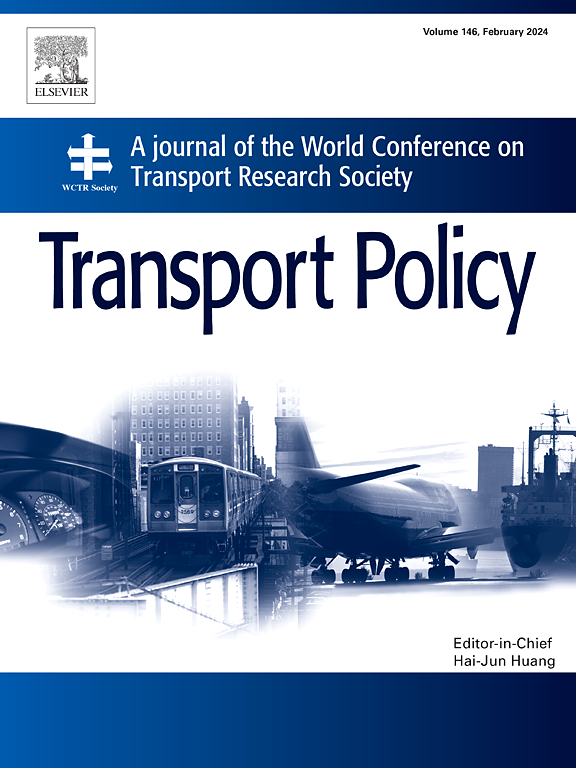Beyond face Validity: Assessment of a participatory value evaluation for an institutionalized transport conflict
IF 6.3
2区 工程技术
Q1 ECONOMICS
引用次数: 0
Abstract
The importance of public participation in transport planning continues to increase. Participatory Value Evaluation (PVE) is a relatively new instrument to involve citizens in transport planning. In a PVE, citizens are put into the shoes of a policymaker and see which polices are considered, the impacts of the policies and the constraint that the policymaker faces. Subsequently, citizens are asked to advise the policymaker on which policy options should be chosen and why.
So far PVE has been successfully applied in contexts in which citizens and stakeholders broadly agreed on the pursued policy goals. It is, however, unclear whether PVE is equally valuable in contexts in which stakeholders have conflicting interests. This paper investigates whether deploying PVE in an institutionalized transport conflict results in similar benefits and costs as in contexts where stakeholders pursue the same goals. We studied a PVE application in which 2466 participants provided recommendations to the government about decision-making regarding Schiphol Airport, the Netherlands. Stakeholders were involved in many phases of and decisions on the PVE design process. The aim of this research was twofold. First, to establish whether the benefits of applying PVE in an institutionalized transport conflict outweigh the costs. Second, to develop an instrument to assess the face validity of PVE as experienced by participants.
We find that PVE can provide similar benefits in the context of an institutionalized conflict compared to cases in which such a conflict was absent. Citizens participated who normally do not participate and the PVE produced useful outcomes for decision-making. However, a notable difference is that the design phase of the PVE involved several feedback rounds which made it much more time-intensive than other cases. Hence, the benefit that PVE requires low time investment of civil servants that emerged in other studies was not applicable when applying PVE to an institutionalized transport conflict setting. Furthermore, stakeholders could not agree on various design choices of the PVE. To satisfy the diverging requests of stakeholders a very lengthy PVE was constructed. As a result, the satisfaction among participants about its face validity was relatively low.
超越表面有效性:制度性交通冲突参与性价值评估的评估
公众参与交通规划的重要性不断增加。参与式价值评价(PVE)是一种让市民参与交通规划的相对较新的工具。在PVE中,公民被置于政策制定者的位置,并看到哪些政策被考虑,政策的影响以及政策制定者面临的约束。随后,公民被要求向政策制定者建议应该选择哪些政策选项以及为什么选择。到目前为止,PVE已经成功地应用于公民和利益相关者对所追求的政策目标广泛同意的环境中。然而,在利益相关者有利益冲突的情况下,PVE是否同样有价值尚不清楚。本文研究了在制度化的运输冲突中部署PVE是否会产生与利益相关者追求相同目标时相似的收益和成本。我们研究了一个PVE应用程序,其中2466名参与者就荷兰史基浦机场的决策向政府提供建议。涉众参与了PVE设计过程的许多阶段和决策。这项研究的目的是双重的。首先,确定在制度化的运输冲突中应用PVE的收益是否大于成本。第二,开发一种工具来评估参与者所经历的PVE的面孔效度。我们发现,与没有这种冲突的情况相比,PVE在制度化冲突的背景下可以提供类似的好处。通常不参与的公民也参与了,PVE为决策产生了有用的结果。然而,一个显著的区别是,PVE的设计阶段涉及几轮反馈,这使得它比其他情况更加耗时。因此,在其他研究中出现的PVE需要公务员投入较少时间的好处,在将PVE应用于制度化的交通冲突环境时并不适用。此外,利益相关者无法就PVE的各种设计选择达成一致。为了满足利益相关者的不同需求,构建了一个非常长的PVE。因此,被试对其面孔效度的满意度相对较低。
本文章由计算机程序翻译,如有差异,请以英文原文为准。
求助全文
约1分钟内获得全文
求助全文
来源期刊

Transport Policy
Multiple-
CiteScore
12.10
自引率
10.30%
发文量
282
期刊介绍:
Transport Policy is an international journal aimed at bridging the gap between theory and practice in transport. Its subject areas reflect the concerns of policymakers in government, industry, voluntary organisations and the public at large, providing independent, original and rigorous analysis to understand how policy decisions have been taken, monitor their effects, and suggest how they may be improved. The journal treats the transport sector comprehensively, and in the context of other sectors including energy, housing, industry and planning. All modes are covered: land, sea and air; road and rail; public and private; motorised and non-motorised; passenger and freight.
 求助内容:
求助内容: 应助结果提醒方式:
应助结果提醒方式:


